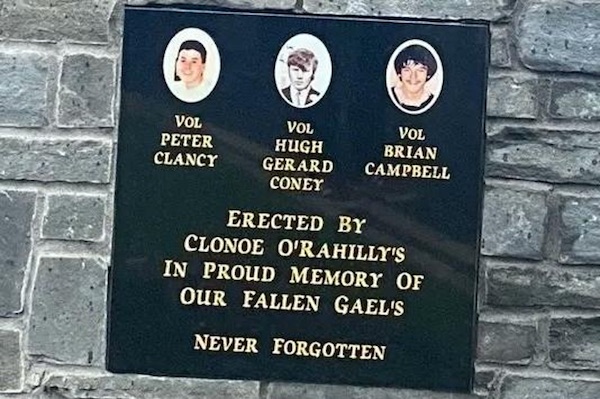
Unionists stand accused of hypocrisy after they criticised a memorial at a Gaelic sports club to former members of the club who died as IRA Volunteers in the line of duty.
Among those attending the weekend unveiling in Clonoe, County Tyrone, was Sinn Féin deputy leader Michelle O’Neill, who is from the area.
A post on Facebook showed the new plaque to three former players at Clonoe O’Rahilly’s Gaelic Athletics Club — Peter Clancy, Hugh Gerard Coney and Brian Campbell.
All three died on active service in different decades of the armed struggle against the British occupation.
The plaque on the memorial states it was erected by Clonoe O’Rahilly’s “in proud memory of our fallen Gaels”, adding they are “never forgotten”.
Peter Clancy is one of the four famous Clonoe martyrs, shot dead by the SAS on the grounds of St Patrick’s Church in Clonoe in February 1992. They were killed as part of the British shoot-to-kill strategy of targeted assassinations.
Brian Campbell was 19 when he was shot dead alongside fellow IRA Volunteer Colm McGirr in December 1983. They were shot in a field near Clonoe after being ambushed by the British Army who had been lying in wait for them. Hugh Gerard Coney was 24 and an internee at Long Kesh prison camp when he was shot dead while trying to escape in 1974.
Memorials to fallen IRA Volunteers from different phases of the struggle are common at Gaelic venues across Ireland, and some clubs are named after legendary IRA figures.
On the other hand, memorials to fallen members of the British Crown Forces are ubiquitous in social, sports and religious location across the north of Ireland, and quite common south of the border.
Nonetheless, DUP deputy leader Paula Bradley claimed the Clonoe event was a new attempt to “normalise” the IRA.
Ms Bradley said: “Those commemorated at this event are defined not by the fact they were members of a GAA club but by their participation in terrorist attacks.
“That definition is crystallised by a memorial which highlights their status as ‘volunteers’ above anything else.”
Republicans have frequently condemned attempts to censor commemorations or distinguish between ‘good’ and ‘bad’ IRA campaigns.
In a brief statement, a spokesperson for Sinn Féin said: “Under the Good Friday Agreement, everyone has the right to remember their dead with dignity and respect.”
The controversy also arose as the President of Ireland and Taoiseach Micheal Martin both took part in a commemoration for those died in the Clonmult ambush over a century ago, when 12 IRA Volunteers were killed by British forces.
Paying tribute to the Volunteers of the East Cork Flying Column and two other IRA Volunteers captured there and executed, Mr Higgins said their sacrifice in the fight for Irish freedom would “live on” in the memories of all present and the generations to come.
The President said that authentic and inclusive commemorations must involve an honest recognition of the facts of history.
“There is no future in any kind of affected amnesia and recognising the facts, we allow that there are different versions as time went on, but we must not be burdened by distortion or abuse of the past,” he said.
![[Irish Republican News]](https://republican-news.org/graphics/title_gifs/rn.gif)
![[Irish Republican News]](https://republican-news.org/graphics/title_gifs/harp.gif)

